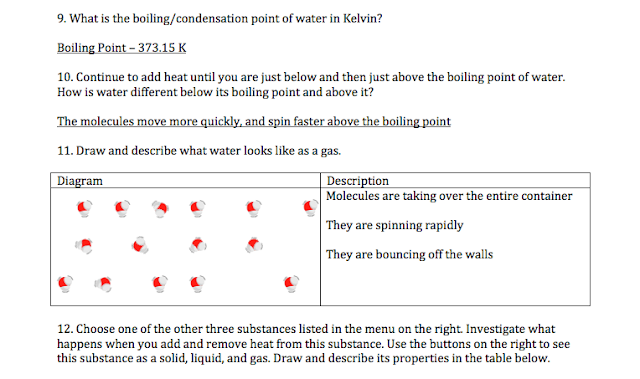Boron
Protons - 5
Neutrons - 6
Electrons - 5
Density - 2.34 g/cm3
Lithium
Protons - 3
Neutrons - 4
Electrons - 3
Density - 0.53 g/cm3
2. Define density and the equation for density and post on your blog.
Density: the quantity of mass per unit volume
Equation for Density: d = m/v
3. Completed Teaching Activity
"PhET- Density Activity- Funsheet"
Custom Section
Material |
Mass (kg) |
Volume (L) |
Density (kg/L) |
Does it Float? |
Styrofoam | 0.28 | 1.85 | 0.15 | Yes |
Wood | 0.74 | 1.85 | 0.40 | Yes |
Ice | 1.70 | 1.85 | 0.92 | Yes |
Brick | 3.70 | 1.85 | 2.0 | No |
Aluminum | 5.00 | 1.85 | 2.70 | No |
1. In the custom setting, choose the ‘My Object’ option in the material drop down box. Set the mass of your object to 4 kg. Adjust the volume to find the minimum volume needed to make the object float.
Volume: 4.01 L Density: 0.998 kg/L
2.
How does the density of a large piece of aluminum compare to a small piece?
Same Mass Section
Material |
Mass (kg) |
Volume (L) |
Density (kg/L) |
Does it Float? |
Blue | 5.00 | 5.00 | 1.00 | Yes |
Yellow | 5.00 | 5.00 | 1.00 | Yes |
Green | 5.00 | 2.5 | 2.00 | No |
Red | 5.00 | 1.25 | 4.00 | No |
Same Volume Section
Material |
Mass (kg) |
Volume (L) |
Density (kg/L) |
Does it Float? |
Blue | 6.00 | 5.00 | 1.20 | No |
Yellow | 8.00 | 5.00 | 1.60 | No |
Green | 4.00 | 4.00 | 1.00 | Yes |
Red | 2.00 | 2.00 | 1.00 | Yes |
3. Looking at the data on the previous page, what must be true about the density of
an object in order for it to float?
The density must equal one in order to float (based on the above data).
4. Calculate the density of the blue object in this section.
Mass: 3.00 kg Volume: 3.00 L Density: 1.00 mg/L
5. Explain why both the yellow and red objects float when they have different sizes.
They both float because they both have a density equal to one.
6. Before you start, pick an object that you think will float: A (random guess)
Pick an object that you think will sink. B (random guess)
Material |
Mass (kg) |
Volume (L) |
Density (kg/L) |
Does it Float? |
A | 65.14 | 3.38 | 19.27 | No |
B | 0.64 | 0.64 | 1.00 | Yes |
C | 4.08 | 4.08 | 1.00 | Yes |
D | 3.10 | 3.10 | 1.00 | Yes |
E | 3.53 | 1.00 | 3.53 | No |
7. In the Custom section describe the difference between how Styrofoam and ice
floated. Also explain why you think this is the case?
Styrofoam was almost completely out of the water while floating while ice was almost completely under water while floating. This is true because Styrofoam has a lower density than ice.
8. In the Same Mass Section discuss what was interesting about the blue object’s behavior in the water.
The blue object stayed wherever I put it. I found this to be very bizarre.
9. In the Mystery Section, click on the “Show Table” button. What is the most dense
object on the list? Write its density as well.
Gold is the densest object. It’s density is 19.3 kg/L.
10. List something you learned from this activity.
In regards to this worksheet, I learned that diamond had a density of 3.53 kg/L.
In regards to this assignment, I learned that there are many different “programs” available to assist students with science related topics such as density. I found this application to be extremely interesting and very useful for a classroom setting
4. Mystery Blocks
Material |
Mass (kg) |
Volume (L) |
Density (kg/L) |
Does it Float? |
A – Gold | 65.14 | 3.38 | 19.27 | No |
B – Water | 0.64 | 0.64 | 1.00 | Yes |
C – Water | 4.08 | 4.08 | 1.00 | Yes |
D – Water | 3.10 | 3.10 | 1.00 | Yes |
E – Diamond | 3.53 | 1.00 | 3.53 | No |
5. Science Standards
Some include...
D.4.1 Understand that objects are made of more than one substance, by observing, describing and
measuring the properties of earth materials, including properties of size,
weight, shape, color, temperature, and the ability to react with other substance
C.4.2 Use the science content being learned to ask questions, plan investigations, make observations, make predictions, and offer explanations
C.4.5 Use data they have collected to develop explanations and answer questions generated by investigations
C.4.6 Communicate the results of their investigations in ways their audiences will understand by using charts, graphs, drawings, written descriptions, and various other means, to display their answers
C.4.7 Support their conclusions with logical arguments
C.8.5 Use accepted scientific knowledge, models*, and theories* to explain* their results and to raise further questions about their investigations*
C.8.6 State what they have learned from investigations*, relating their inferences* to scientific knowledge and to data they have collected
C.8.8 Use computer software and other technologies to organize, process, and present their data
































